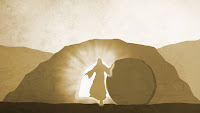“For what I received I passed on to you as of first importance: that Christ died for our sins according to the Scriptures, that he was buried, that he was raised on the third day according to the Scriptures, and that he appeared ...” (1Cor 15:3-5).
Christianity alone, out of all the religions in the world, tells you how to prove that it’s false: produce the body. OK, two thousand years later, that would be impossible. But to the modern world we can offer a similar challenge: give us a better explanation for the facts.
What facts? Gary Habermas offers a list of 12 facts that, with one exception, are “accepted as historical by virtually all [90%+] scholars who research this area”,1 be they evangelicals, liberals, or even non-Christians. He also says that you don’t even need all 12 to prove the resurrection happened. I would use these five:
- Jesus died by Roman crucifixion.
- The disciples had experiences they thought were appearances of the risen Jesus.
- The apostles began teaching the resurrection of Christ very soon afterwards in Jerusalem, the city where Jesus was executed and buried.
- James, the brother of Jesus and a former skeptic, and Saul (Paul), the church persecutor, became Christians due to experiences they believed were appearances of the risen Jesus.
- Christ’s tomb was empty. (This is the exception. Habermas says only about 75% accept this as fact.)
Anyone wishing to disprove Christianity simply needs to come up with a better explanation for the above facts than the resurrection. And people have tried. We will look at several alternative theories.
Legendary development: Skeptics often claim that the resurrection only became part of Christian teachings decades after the crucifixion, after the “witnesses” were dead and long after Christ’s body would have decayed beyond recognition. But today there are several noteworthy skeptical NT scholars who agree that the teaching of the resurrection happened within a few months to a few years of the crucifixion. For instance, Bart Ehrman2 believes that the creed reproduced in 1Cor 15:3-7 would have been established within 3-5 years of Christ’s death, meaning that the teaching would have begun even earlier. Scholars generally agree that the resurrection was preached at most a few months after the crucifixion. This means those who claimed to see him after his death were the ones teaching the resurrection. So legendary development is not a plausible alternative.
Swoon theory: The idea that Jesus didn’t actually die on the cross comes into fashion every once in a while. It’s interesting that no one suggested this until long after crucifixions were no longer carried out. Experts believe Jesus actually died on the cross because Roman soldiers were very good at killing people. If Jesus had somehow fooled everyone into merely thinking he was dead, the spear in his side would have ended the charade. If by some odd chance he survived the crucifixion and the time in the tomb without medical care, he would then have to get himself out of the tomb (the stone would have weighed tons) and avoid the guards. And after all he had endured (the flogging, the crucifixion, the spear, the time in the tomb), it’s unlikely he would convince his followers he had “conquered death.”
Stolen body: The idea that the disciples stole Christ’s body is the first alternative theory we know about. But the idea that the same men who fled and hid during his arrest would then find the nerve to steal his body from a guarded, sealed tomb and then insist on proclaiming his resurrection even after the deaths of Stephen and James is too ridiculous to imagine. This theory also fails to explain the conversion of skeptics.
Hallucination: What if the disciples only thought Jesus appeared to them? What if they wanted him to live so badly they convinced themselves that he had returned from the dead? As much trouble as they caused with their preaching, the Jewish leaders or the Romans would have simply trotted out the body. But the tomb was empty; how did that happen? And even though people can have such hallucinations, people cannot share hallucinations. One disciple might think he saw the risen Christ, but not a dozen, much less 500 of them. Additionally, skeptics like James and Paul would not be susceptible to those hallucinations.
Copy of pagan myths: Some claim that the Christian resurrection story was copied from pagan myths of dying and rising gods. When the similarities are closely examined, though, they quickly fall apart, and the more similar the mythic element is, the more likely it is to have appeared after Christianity. And, ultimately, no amount of similarities to these myths explains the historical data.
History has shown that skeptics are endlessly creative when it comes to alternative theories to explain away the resurrection, but in the end they all fail to adequately explain the historical facts. “But no theory is as implausible as the idea that someone rose from the dead.” In a naturalistic world, that would be true. But if God can create a universe out of nothing, he can certainly reanimate a corpse. And as long as miracles are possible, a resurrection is a much better explanation for the historical facts.
We need to be confident that Christ was raised from the dead. “If Christ has not been raised, your faith is futile; you are still in your sins. Then those also who have fallen asleep in Christ are lost. If only for this life we have hope in Christ, we are of all people most to be pitied.
“But Christ has indeed been raised from the dead, the firstfruits of those who have fallen asleep” (1Cor 15:17-20).
For more on this topic, including more skeptical alternative theories, I recommend The Case for the Resurrection of Jesus by Gary Habermas and Michael Licona.
1 Gary Habermas, The Risen Jesus & Future Hope
2 Bart Ehrman, Did Jesus Exist?
image credit: JeffJacobs1990 via pixabay


